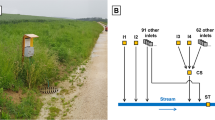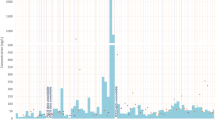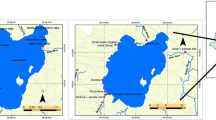Abstract
Small water bodies (SWB) are freshwater ecosystems of high ecological relevance. However, they receive considerably higher inputs of pesticides compared to larger water bodies owing to their close connection to adjacent agricultural fields in combination with their low water volume or discharge. Monitoring of the pesticide contamination of lentic and lotic SWB is a challenging task as various spatial and temporal factors affect pesticide’s maximum peak concentrations in the water bodies. We present an overview of the major challenges that can complicate the detection of exceedances of regulatory acceptable concentrations. Pesticide data from streams encompassed by the Danish pesticide monitoring program show that the highest pesticide concentrations are found in SWB. A ditch monitoring in a German orchard reveals that event-driven sampling following spray application outperforms the widely used automatic water sampling at fixed intervals, and we therefore suggest that the latter should replace the former in SWB. Furthermore, we suggest that gathering of quantitative data on pesticide pollution of lentic SWB should be given priority in future research.



Similar content being viewed by others
References
Allan, J. D. & M. M. Castillo, 2007. Stream Ecology: Structure and Function of Running Waters, 2nd ed. Springer, Dordrecht.
Altenfelder, S., U. Raabe & H. Albrecht, 2014. Effects of water regime and agricultural land use on diversity and species composition of vascular plants inhabiting temporary ponds in northeastern Germany. Tuexenia 34: 145–162.
Barzman, M., P. Bàrberi, N. E. Birch, P. Boonekamp, S. Dachbrodt-Saaydeh, B. Graf, B. Hommel, J. E. Jensen, J. Kiss, P. Kudsk, J. R. Lamichhane, A. Messéan, A.-C. Moonen, A. Ratnadass, P. Ricci, J.-L. Sarah & M. Sattin, 2015. Eight principles of integrated pest management. Agronomy for Sustainable Development 35: 1199–1215.
Beketov, M. A., B. J. Kefford, R. B. Schäfer & M. Liess, 2013. Pesticides reduce regional biodiversity of stream invertebrates. Proceedings of the National Academy of Sciences 110: 11039–11043.
Bereswill, R., B. Golla, M. Streloke & R. Schulz, 2012. Entry and toxicity of organic pesticides and copper in vineyard streams: erosion rills jeopardize the efficiency of riparian buffer strips. Agriculture, Ecosystems & Environment 146: 81–92.
Berger, G., P. Pfeffer & T. Kalettka (eds), 2011. Amphibienschutz in kleingewässerreichen Ackerbaugebieten – Grundlagen, Konflikte, Lösungen. Natur & Text, Rangsdorf.
Biggs, J., P. Williams, M. Whitfield, P. Nicolet, C. Brown, J. Hollis, D. Arnold & T. Pepper, 2007. The freshwater biota of British agricultural landscapes and their sensitivity to pesticides. Agriculture, Ecosystems & Environment 122: 137–148.
Biggs, J., P. Nicolet, M. Mlinaric & T. Lalanne, 2014. Report of the Workshop on the Protection and Management of Small Water Bodies, Brussels, 14th November 2013. The European Environmental Bureau (EEB) and the Freshwater Habitats Trust: 23 p.
Bischoff, G., M. Stähler, K. Ehlers & W. Pestemer, 2003. Biological-chemical monitoring in drainage ditches in the ‘Altes Land’ orchading region. Part 1: Application of plant protection products and residues of a.i. in surface water. In Del Re, A., E. Capri, L. Padovani & M. Trevisan (eds), Pesticide in air, plant, soil & water system. Proceedings of the 12. Symposium Pesticide Chemistry, Piacenza, Italia: 831–840.
Brock, T. C. M., J. D. M. Belgers, I. Roessink, J. G. M. Cuppen & S. J. Maund, 2010. Macroinvertebrate responses to insecticide application between sprayed and adjacent nonsprayed ditch sections of different sizes. Environmental Toxicology and Chemistry 29: 1994–2008.
Bundschuh, M., J. P. Zubrod, P. Klemm, D. Elsaesser, C. Stang & R. Schulz, 2013. Effects of peak exposure scenarios on Gammarus fossarum using field relevant pesticide mixtures. Ecotoxicology and Environmental Safety 95: 137–143.
Bundschuh, M., W. Goedkoop & J. Kreuger, 2014. Evaluation of pesticide monitoring strategies in agricultural streams based on the toxic-unit concept – experiences from long-term measurements. Science of the Total Environment 484: 84–91.
Caquet, C., M. Hanson, M. Roucaute, D. Graham & L. Lagadi, 2007. Influence of isolation on the recovery of pond mesocosms from the application of an insecticide. II Benthic macroinvertebrate responses. Environmental Toxicology and Chemistry 26: 1280–1290.
Carrara, F., F. Altermatt, I. Rodriguez-Iturbe & A. Rinaldo, 2012. Dendritic connectivity controls biodiversity patterns in experimental metacommunities. Proceedings of the National Academy of Sciences 109: 5761–5766.
Clements, W. H., D. R. Kashian, P. M. Kiffney & R. E. Zuellig, 2015. Perspectives on the context-dependency of stream community responses to contaminants. Freshwater Biology. doi:10.1111/fwb.12599.
Davies, B., J. Biggs, P. Williams, M. Whitfield, P. Nicolet, D. Sear, S. Bray & S. Maund, 2008a. Comparative biodiversity of aquatic habitats in the European agricultural landscape. Agriculture, Ecosystems & Environment 125: 1–8.
Davies, B. R., J. Biggs, P. J. Williams, J. T. Lee & S. Thompson, 2008b. A comparison of the catchment sizes of rivers, streams, ponds, ditches and lakes: implications for protecting aquatic biodiversity in an agricultural landscape. Hydrobiologia 597: 7–17.
Day, K. E., 1990. Pesticide residues in freshwater and marine zooplankton: a review. Environmental Pollution 67: 205–222.
De Bie, T., S. Declerck, K. Martens, L. De Meester & L. Brendonck, 2008. A comparative analysis of cladoceran communities from different water body types: patterns in community composition and diversity. Hydrobiologia 597: 19–27.
Della Bella, V., M. Bazzanti, M. G. Dowgiallo & M. Imberite, 2008. Macrophyte diversity and physico-chemical characteristics of Tyrrhenian coast ponds in central Italy: implications for conservation. Hydrobiologia 597: 85–95.
Dodds, W. K. & R. M. Oakes, 2008. Headwater influences on downstream water quality. Environmental Management 41: 367–377.
Downing, J. A., Y. T. Prairie, J. J. Cole, C. M. Duarte, L. J. Tranvik, R. G. Striegl, W. H. McDowell, P. Kortelainen, N. F. Caracao, J. M. Melack & J. J. Middelburg, 2006. The global abundance and size distribution of lakes, ponds, and impoundments. Limnology and Oceanography 51: 2388–2397.
EC (European Commission), 2009. Directive 2009/128/EC of the European Parliament and of the Council of 21 October 2009 establishing a framework for Community action to achieve the sustainable use of pesticides.
Fernández, D., E. L. M. Vermeirssen, N. Bandow, K. Muñoz & R. B. Schäfer, 2014. Calibration and field application of passive sampling for episodic exposure to polar organic pesticides in streams. Environmental Pollution 194: 196–202.
Fernández, D., K. Voss, M. Bundschuh, J. P. Zubrod & R. B. Schäfer, 2015. Effects of fungicides on decomposer communities and litter decomposition in vineyard streams. Science of the Total Environment 533: 40–48.
Focks, A., M. ter Horst, E. van den Berg, H. Baveco & P. J. van den Brink, 2014. Integrating chemical fate and population-level effect models for pesticides at landscape scale: new options for risk assessment. Ecological Modelling 280: 102–116.
Gilliom, R. J., 2007. Pesticides in U.S. streams and groundwater. Environmental Science & Technology 41: 3408–3414.
Globevnik, L., 2007. Briefing Small Water Bodies. Report of the European Environment Agency (No. EEA/ADS/06/001 – Water).
Goldyn, B., R. Bernard, M. J. Czyz & A. Jankowiak, 2012. Diversity and conservation status of large branchipods (Crustacea) in ponds of western Poland. Limnologica 42: 264–270.
Hageman, K. J., S. L. Simonich, D. H. Campbell, G. R. Wilson & D. H. Landers, 2006. Atmospheric deposition of current-use and historic-use pesticides in snow at national parks in the Western United States. Environmental Science & Technology 40: 3174–3180.
Hahn, T., M. Liess & R. Schulz, 2001. Effects of the hormone mimetic insecticide tebufenozide on Chironomus riparius larvae in two different exposure setups. Ecotoxicology and Environmental Safety 49: 171–178.
Holgerson, M. A. & P. A. Raymond, 2016. Large contribution to inland water CO2 and CH4 emissions from very small ponds. Nature Geoscience 9: 222–226.
Holvoet, K., P. Seuntjens, R. Mannaerts, V. De Schepper & P. A. Vanrolleghem, 2007. The dynamic water–sediment system: results from an intensive pesticide monitoring campaign. Water Science and Technology 55: 177–182.
House, W. A., 1994. Sampling techniques for organic substances in surface waters. International Journal of Environmental Analytical Chemistry 57: 207–214.
Hull, R. N., S. Kleywegt & J. Schroeder, 2015. Risk-based screening of selected contaminants in the Great Lakes Basin. Journal of Great Lakes Research 41: 238–245.
Jager, T., 2012. Bad habits die hard: the NOEC’s persistence reflects poorly on ecotoxicology. Environmental Toxicology and Chemistry 31: 228–229.
Kreuger, J., 1998. Pesticides in stream water within an agricultural catchment in southern Sweden, 1990–1996. Science of the Total Environment 216: 227–251.
Kreuger, J. & L. Tornqvist, 1998. Multiple regression analysis of pesticide occurrence in streamflow related to pesticide properties and quantities applied. Chemosphere 37: 189–207.
Kronvang, B., H. L. Strom, C. C. Hoffmann, A. Laubel & N. Friberg, 2004. Subsurface tile drainage loss of modern pesticides: field experiment results. Water Science and Technology 49: 139–147.
Laabs, V., W. Amelung, A. A. Pinto, M. Wantzen, C. J. da Silva & W. Zech, 2002. Pesticides in surface water, sediment, and rainfall of the northeastern Pantanal Basin, Brazil. Journal of Environmental Quality 31: 1636–1648.
Laskowski, R., 1995. Some good reasons to ban the use of NOEC, LOEC and related concepts in ecotoxicology. Oikos 7: 140–144.
Leu, C., H. Singer, C. Stamm, S. R. Muller & R. P. Schwarzenbach, 2004a. Variability of herbicide losses from 13 fields to surface water within a small catchment after a controlled herbicide application. Environmental Science & Technology 38: 3835–3841.
Leu, C., H. Singer, C. Stamm, S. R. Muller & R. P. Schwarzenbach, 2004b. Simultaneous assessment of sources, processes and factors influencing herbicide losses to surface waters in a small agricultural catchment. Environmental Science and Technology 38: 3827–3834.
Lewis, K. A., J. Tzilivakis, D. Warner & A. Green, 2016. An international database for pesticide risk assessments and management. Human and Ecological Risk Assessment: An International Journal. doi:10.1080/10807039.2015.1133242.
Liess, M. & P. von der Ohe, 2005. Analyzing effects of pesticides on invertebrate communities in streams. Environmental Toxicology and Chemistry 24: 954–965.
Malaj, E., P. C. von der Ohe, M. Grote, R. Kühne, C. P. Mondy, P. Usseglio-Polatera, W. Brack & R. B. Schäfer, 2014. Organic chemicals jeopardize the health of freshwater ecosystems on the continental scale. Proceedings of the National Academy of Sciences 111: 9549–9554.
Mills, G. A., A. Gravell, B. Vrana, C. Harman, H. Budzinski, N. Mazella & T. Ocelka, 2014. Measurement of environmental pollutants using passive sampling devices – an updated commentary on the current state of the art. Environmental Science: Processes & Impacts 16: 369–373.
Múrria, C., N. Bonada, M. A. Arnedo, N. Prat & A. P. Vogler, 2013. Higher β- and γ-diversity at species and genetic levels in headwaters than in mid-order streams in Hydropsyche (Trichoptera). Freshwater Biology 58: 2226–2236.
Nanos, T., K. Boye & J. Kreuger, 2012. Results from the Environmental Monitoring of Pesticides (in Swedish). Swedish University of Agricultural Sciences, Uppsala.
Nolby, L. E., K. D. Zimmer, M. A. Hanson & B. R. Herwig, 2015. Is the island biogeography model a poor predictor of biodiversity patterns in shallow lakes? Freshwater Biology 60: 870–880.
Oertli, B., D. A. Joye, N. Indermuehle, R. Juge & J.-B. Lachavanne, 2004. 1st European pond workshop ‘Conservation and monitoring of pond biodiversity’. Archives des Sciences 57: 69–71.
Oertli, B., N. Indermuehle, S. Angélibert, H. Hinden & A. Stoll, 2008. Macroinvertebrate assemblages in 25 high alpine ponds of the Swiss National Park (Cirque of Marcun) and relation to environmental variables. Hydrobiologia 597: 29–41.
Pätzig, M., T. Kalettka, M. Glemnitz & G. Berger, 2012. What governs macrophyte species richness in kettle hole types? A case study from Northeast Germany. Limnologica 42: 340–354.
Rabiet, M., C. Margoum, V. Gouy, N. Carluer & M. Coquery, 2010. Assessing pesticide concentrations and fluxes in the stream of a small vineyard catchment – effect of sampling frequency. Environmental Pollution 158: 737–748.
Rannap, R., A. Löhmuss & L. Briggs, 2009. Restoring ponds for amphibian: a success story. Hydrobiologia 634: 87–95.
Rasmussen, J. J., P. Wiberg-Larsen, A. Baattrup-Pedersen, N. Cedergreen, U. S. McKnight, J. Kreuger, D. Jacobsen & N. Friberg, 2015. The legacy of pesticide pollution: an overlooked factor in current risk assessments of freshwater systems. Water Research 84: 25–32.
Richards, R. P. & D. B. Baker, 1993. Pesticide concentration patterns in agricultural drainage networks in the Lake Erie basin. Environmental Toxicology and Chemistry 12: 13–26.
Sanders, H. O., 1969. Toxicity of Pesticides to the Crustacean Gammarus lacustris. Technical Paper No. 25, U.S. Dept. of the Interior, Fish and Wildlife Service, Bureau of Sport Fisheries and Wildlife, 18 pp.
Sanders, H. O., 1972. Toxicity of Some Insecticides to Four Species of Malacostracan Crustaceans. Technical Paper No. 66, U.S. Dept. of the Interior, Fish and Wildlife Service, Bureau of Sport Fisheries and Wildlife, 19 pp.
Schäfer, R. B., A. Paschke, B. Vrana, R. Mueller, & M. Liess, 2008. Performance of the Chemcatcher passive sampler when used to monitor 10 polar and semi-polar pesticides in 16 Central European streams, and comparison with two other sampling methods. Water Research 42: 2707–2717.
Schäfer, R. B., P. J. van den Brink & M. Liess, 2011a. Impacts of Pesticides on Freshwater Ecosystems. In Sanchez-Bayo, F., P. van den Brink & R. M. Mann (eds), Ecological Impacts of Toxic Chemicals. Bentham, Bussum, NL: 111–137.
Schäfer, R. B., P. von der Ohe, R. Kühne, G. Schüürmann & M. Liess, 2011b. Occurrence of 331 organic pollutants in four rivers of North Germany between 1994 and 2004 and risk assessment for algae, invertebrates and fish. Environmental Science & Technology 45: 6167–6174.
Schäfer, R. B., P. von der Ohe, J. Rasmussen, J. B. Kefford, M. Beketov, R. Schulz & M. Liess, 2012. Thresholds for the effects of pesticides on invertebrate communities and leaf breakdown in stream ecosystems. Environmental Science and Technology 46: 5134–5142.
Schulz, R. & M. Liess, 2000. Toxicity of fenvalerate to caddisfly larvae: chronic effects of 1- vs 10-h pulse-exposure with constant doses. Chemosphere 41: 1511–1517.
Schulz, R., 2004. Field studies on exposure, effects, and risk mitigation of aquatic nonpoint-source insecticide pollution: a review. Journal of Environmental Quality 33: 419–448.
Smiley, P. C., K. W. King & N. R. Fausey, 2014. Annual and seasonal differences in pesticide mixtures within channelized agricultural headwater streams in central Ohio. Agriculture, Ecosystems & Environment 193: 83–95.
Stehle, S. & R. Schulz, 2015. Agricultural insecticides threaten surface waters at the global scale. Proceedings of the National Academy of Sciences 112: 5570–5575.
Stehle, S., A. Knäbel & R. Schulz, 2013. Probabilistic risk assessment of insecticide concentrations in agricultural surface waters: a critical appraisal. Environmental Monitoring and Assessment 185: 6295–6310.
Stenrød, M., 2015. Long-term trends of pesticides in Norwegian agricultural streams and potential future challenges in northern climate. Acta Agriculturae Scandinavica, Section B - Soil & Plant Science 65(sup2): 199–216.
Stuer-Lauridsen, F., 2005. Review of passive accumulation devices for monitoring organic micropollutants in the aquatic environment. Environmental Pollution 136: 503–524.
Süß, A., G. Bischoff, A. C. W. Mueller & L. Buhr, 2006. Chemical and biological monitoring of the load of plant protection products and of zoocoenoses in ditches of the orchard region “Altes Land”. Nachrichtenblatt des Deutschen Pflanzenschutzdienstes 58: 28–42.
Taghavi, L., J. Probst, G. Merlina, A. Marchand, G. Durbe & A. Probst, 2010. Flood event impact on pesticide transfer in a small agricultural catchment (Montoussé at Auradé, south west France). International Journal of Environmental Analytical Chemistry 90: 390–405.
Thomson Reuters, 2015. 2015 Journal Citation Reports®.
Tonkin, J. D., S. Stoll, S. C. Jähnig & P. Haase, 2015. Contrasting metacommunity structure and beta diversity in an aquatic-floodplain system. Oikos 125: 686–697.
Trekels, H., F. van de Meutter & R. Stoks, 2011. Habitat isolation shapes the recovery of aquatic insect communities from a pesticide pulse. Journal of Applied Ecology 48: 1480–1489.
Ulrich, U., C. Krüger, G. Hörmann & N. Fohrer, 2015. Pesticide contamination of German small water bodies: a status report. Hydrologie und Wasserbewirtschaftung 59: 227–238.
Van de Zande, J. C., H. A. J. Porskamp, J. M. G. P. Michielsen, H. J. Holterman & J. M. F. Huijsmans, 2000. Classification of spray applications for driftability, to protect surface water. Aspects of Applied Biology 57: 57–64.
Van der Hoeven, N., 1997. How to measure no effect. Part III: statistical aspects of noec, exc and nec estimates. Environmetrics 8: 255–261.
Von der Ohe, P. C. & M. Liess, 2004. Relative sensitivity distribution of aquatic invertebrates to organic and metal compounds. Environmental Toxicology and Chemistry 23: 150–156.
Vrana, B., I. J. Allan, R. Greenwood, G. A. Mills, E. Dominiak, K. Svensson, J. Knutsson & G. Morrison, 2005. Passive sampling techniques for monitoring pollutants in water. Trends in Analytical Chemistry 24: 845–868.
Wauchope, R. D., 1978. The pesticide content of surface water draining from agricultural fields – a review. Journal of Environmental Quality 7: 459–472.
Waldon, B., 2012. The conservation of small reservoirs in the Krajènskie Lakeland (North-West Poland). Limnologica 42: 320–327.
Williams, P., J. Whitfield, J. Biggs, S. Bray, G. Fox, P. Nicolet & D. Sear, 2004. Comperative biodiversity of rivers, streams, ditches and ponds in an agricultural landscape in Southern England. Biological Conservation 115: 329–431.
Xing, Z., L. Chow, H. Rees, F. Meng, S. Li, B. Ernst, G. Benoy, T. Zha & L. M. Hewitt, 2013. Influences of sampling methodologies on pesticide-residue detection in stream water. Archives of Environmental Contamination and Toxicology 64: 208–218.
Acknowledgments
The authors thank Karin Fricke, Gerd Palm and Peter Quast for their assistance during field samplings in the German orchard region. We thank Gabriela Bischoff, Ina Stachewicz-Blum, Gabi Smykalla, Kerstin Jänicke, Hartmut Nowak, Frank Seefeld and Walter Tunkel for their help in sample preparation and pesticide analysis. We are also grateful to Anne Mette Poulsen from the Department of Bioscience, Aarhus University, for linguistic assistance and three anonymous referees for very helpful comments on an earlier draft of this manuscript.
Author information
Authors and Affiliations
Corresponding author
Additional information
Guest editors: Mary Kelly-Quinn, Jeremy Biggs & Stefanie von Fumetti / The Importance of Small Water Bodies: Insights from Research
Electronic supplementary material
Below is the link to the electronic supplementary material.
Rights and permissions
About this article
Cite this article
Lorenz, S., Rasmussen, J.J., Süß, A. et al. Specifics and challenges of assessing exposure and effects of pesticides in small water bodies. Hydrobiologia 793, 213–224 (2017). https://doi.org/10.1007/s10750-016-2973-6
Received:
Revised:
Accepted:
Published:
Issue Date:
DOI: https://doi.org/10.1007/s10750-016-2973-6




